Cameo Communications WLG2207 2.4GHz Wireless Broadband Router User Manual M WLG 2207 V3 0
Cameo Communications Inc 2.4GHz Wireless Broadband Router M WLG 2207 V3 0
Users Manual

2.4GHz Wireless
Broadband Router
USER MANUAL

Contents
1. Overview..............................................................................................1
1.1 Product Feature..........................................................................................1
1.2 System Requirements ...............................................................................1
1.3 Applications .................................................................................................1
2. Getting Start ........................................................................................2
2.1 Know the 54Mbps Wireless Router.........................................................2
2.2 Connect to the 54Mbps Wireless Router................................................3
2.2.1 Access the Setting Menu...................................................................3
2.2.2 Quick Setup with Wizard..................................................................5
3. Configuration.....................................................................................12
3.1 LAN Setting ...............................................................................................12
3.1.1 LAN & DHCP Server .....................................................................12
3.1.2 WAN ...............................................................................................13
3.1.3 Password.........................................................................................14
3.1.4 Time ................................................................................................15
3.1.5 Dynamic DNS.................................................................................16
3.2 Wireless .....................................................................................................17
3.2.1 Basic................................................................................................17
3.2.2 Authentication.................................................................................18
3.2.3 Advanced ........................................................................................20
3.3 Status..........................................................................................................22
3.3.1 Device Information.........................................................................22
3.3.2 Log..................................................................................................23
3.3.3 Log Setting......................................................................................24
3.3.4 Statistic............................................................................................25
3.3.5 Wireless...........................................................................................26
3.4 Routing.......................................................................................................27
3.4.1 Static................................................................................................27
3.4.2 Dynamic..........................................................................................28
3.4.3 Routing Table..................................................................................29
3.5 Access........................................................................................................30
3.5.1 Filters..............................................................................................30
3.5.2 Virtual Server..................................................................................34
3.5.3 Special AP.......................................................................................35
3.5.4 DMZ................................................................................................36
3.5.5 Firewall Rule...................................................................................37
3.6 Management .............................................................................................38
3.6.1 SNMP..............................................................................................38
3.6.2 Remote Management......................................................................39
3.7 Tools ...........................................................................................................40
3.7.1 Restart.............................................................................................40
3.7.2 Settings............................................................................................40
3.7.3 Firmware.........................................................................................41
3.7.4 Ping Test..........................................................................................42
4. Glossary ............................................................................................43

1
1. Overview
1.1 Product Feature
? Compliance with IEEE 802.11g and 802.11b standards
? Highly efficient design mechanism to provide unbeatable performance
? Strong network security with WEP and 802.1X encryption
? Achieving data rate up to 54Mbps for 802.11g and 11Mps for 802.11b with wide
range coverage; high performance to deliver up to 54Mbps raw data rate for
802.11g
? Quick and easy setup with Web-based management utility
1.2 System Requirements
? Windows 98, 98SE, Millennium Edition (ME), 2000 and XP operating systems
? Microsoft Internet Explorer 5.5 or higher
? DSL/ Cable Modem Broadband Internet connection and ISP account
? PCs equipped with 10Mbps or 10/100 Mbps Ethernet connection to support
TCP/IP protocol
? One CD-ROM drive
1.3 Applications
? Home SOHO networking for device sharing and wireless multimedia
? Wireless office provides a wider range for home and SOHO Ethernet
? Enables wireless building-to-building data communication
? Built-in infrastructure mode
? Router provides ideal solution for:
? Difficult-to-wire environments
? Temporary LANs for scenarios such as trade-exhibitions and meetings
? Enables LAN adaptability to frequently changing environments
? Enables remote access to corporate network information, for example e-mail and
the company home page
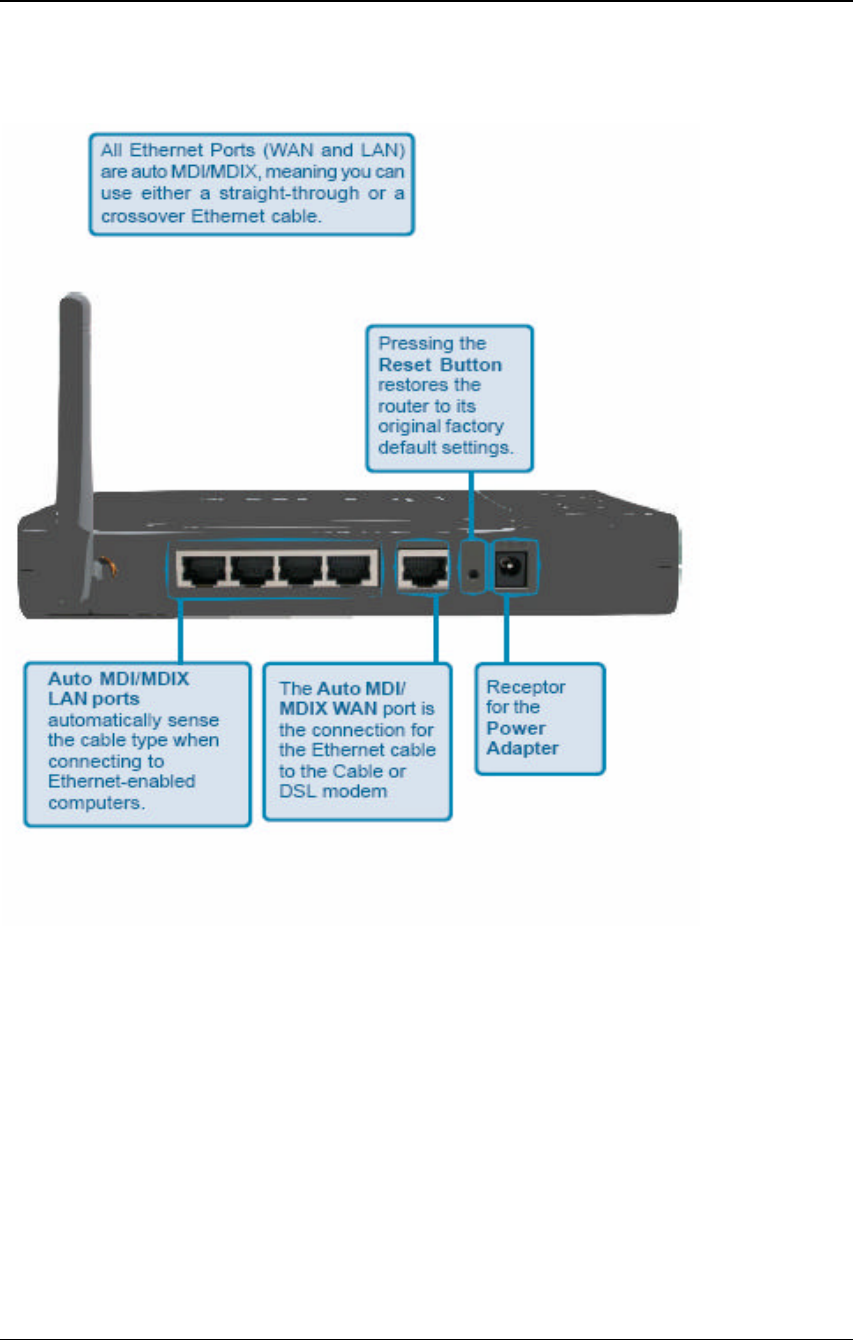
2
2. Getting Start
2.1 Know the 54Mbps Wireless Router
Ports:

3
LEDs:
LED Color Status Description
On Indicates proper connection to power
supply.
Power Green
OFF The unit is not receiving power
Status Green On Indicates that the device is
connected to the WLAN.
On Indicates connection to the WAN port
WAN Blinking Data transmission.
On Link is established
On Blinking Packet transmit or receive activity
WLAN
Off — No Link activity
On Indicates connection is established.
On Blinking Data transmissions LAN
Off — No LAN connections
2.2 Connect to the 54Mbps Wireless Router
2.2.1 Access the Setting Menu
You could start to access the configuration menu anytime by opening a web browser window
by typing the IP address of this wireless router. The default IP is 192.168.1.1.
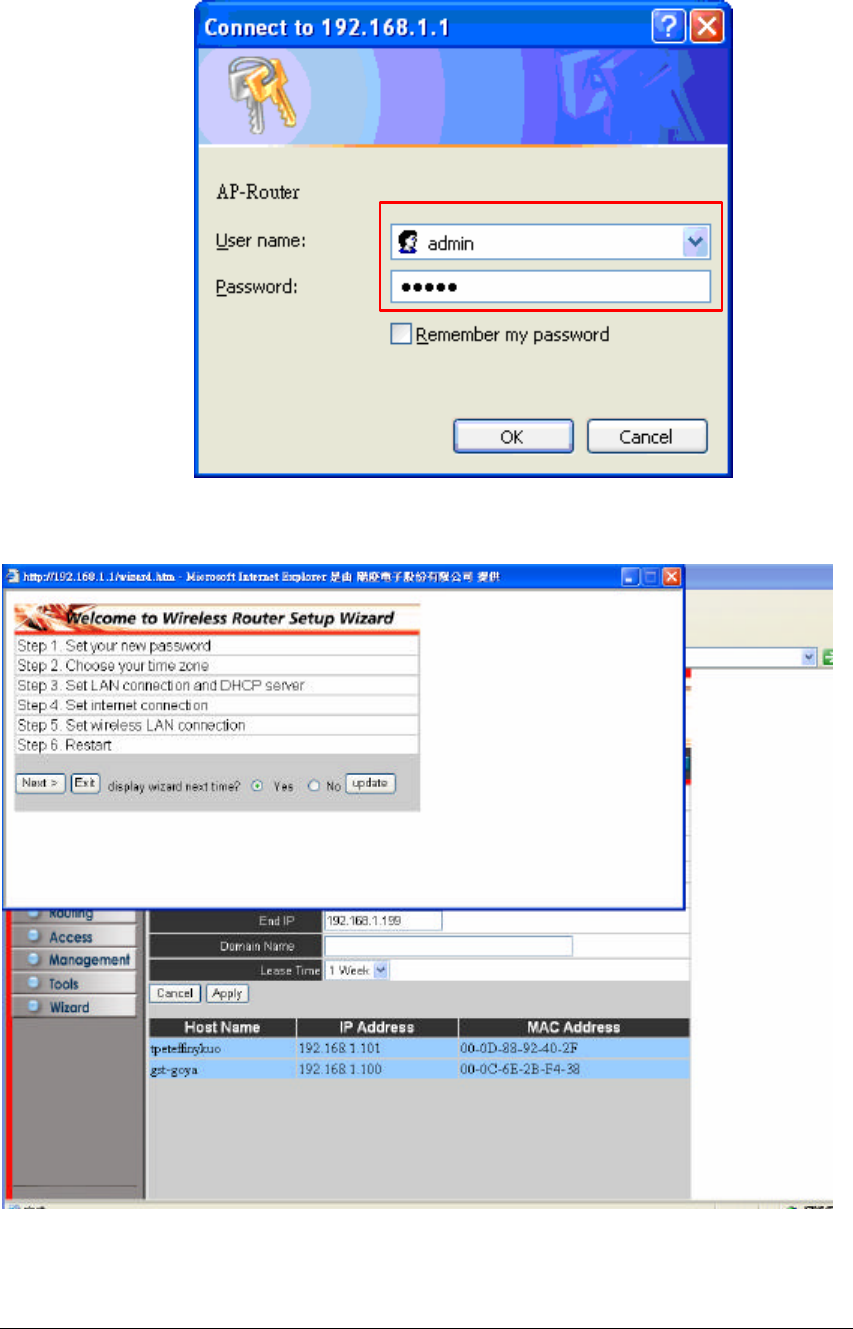
4
The below window will popup. Please enter the user name and password. Both of the
default is “admin”.
Now, the main menu screen is popup.
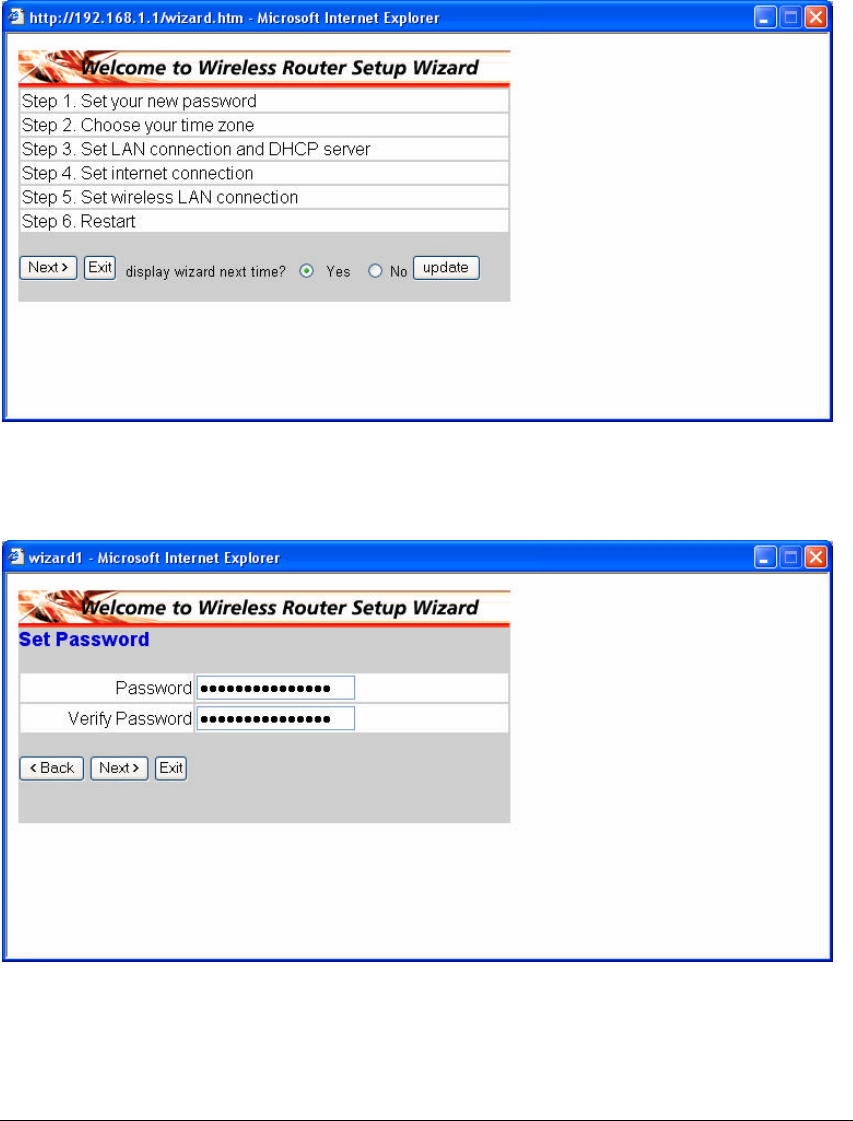
5
2.2.2 Quick Setup with Wizard
Setup wizard is provided as the part of the web configuration utility. You can simply
follow the step-by-step process to get your wireless router configuration ready to run in
6 easy steps by clicking on the “Wizard” button on the function menu. The following
screen will appear. Please click “Next” to continue.
Step 1: Set your new Password
You can change the password as you like and then click “Next” to continue.
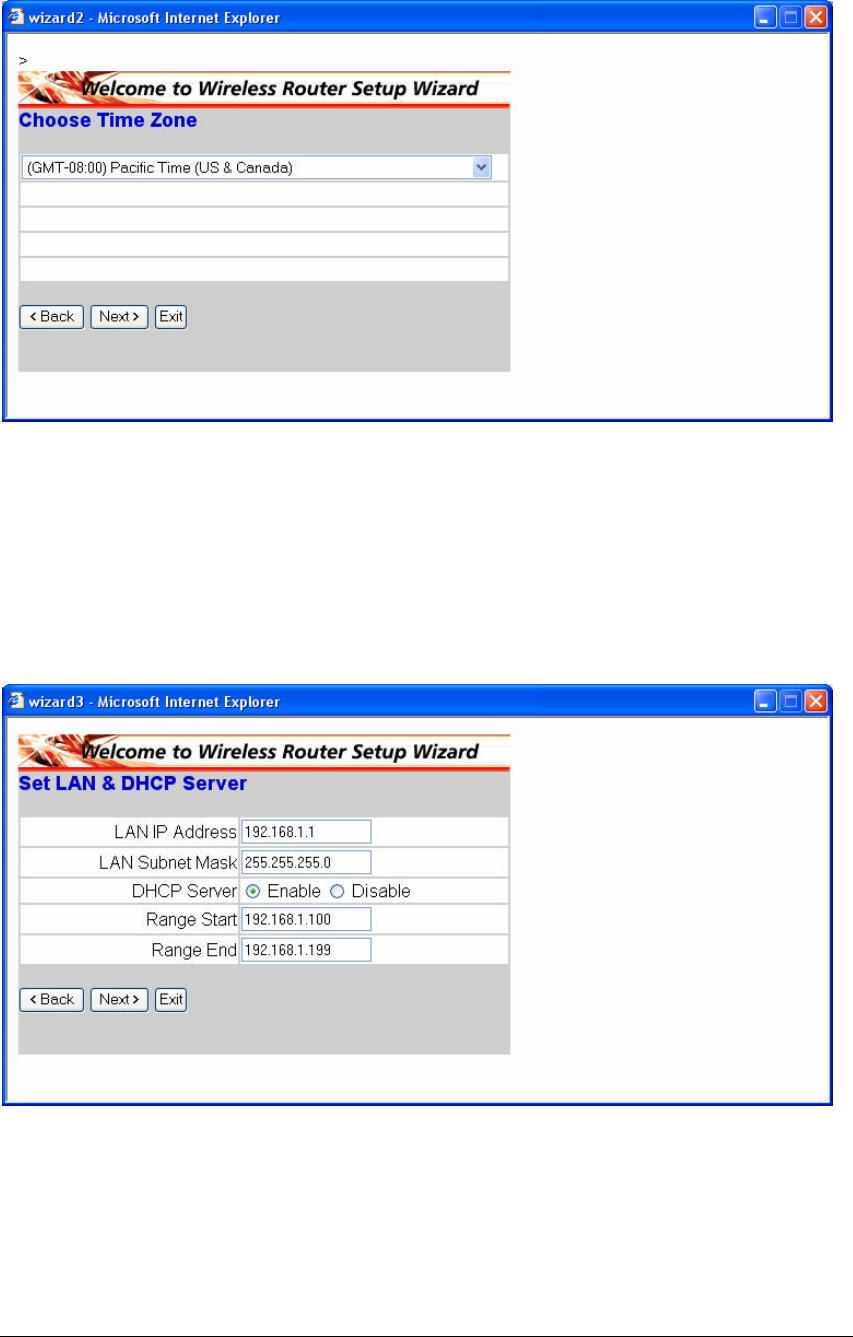
6
Step2: Choose your time zone
Select your time zone from the drop down list. Please click “Next” to continue.
Step 3: Set LAN connection and DHCP server
Set your IP address and mask. The default IP is 192.168.1.1. If you like to enable
DHCP, please click “Enabled”. DHCP enabled is able to automatically assign IP
addresses. Please assign the range of IP addresses in the fields of “Range start”
and “Range end”. Please click “Next” to continue.
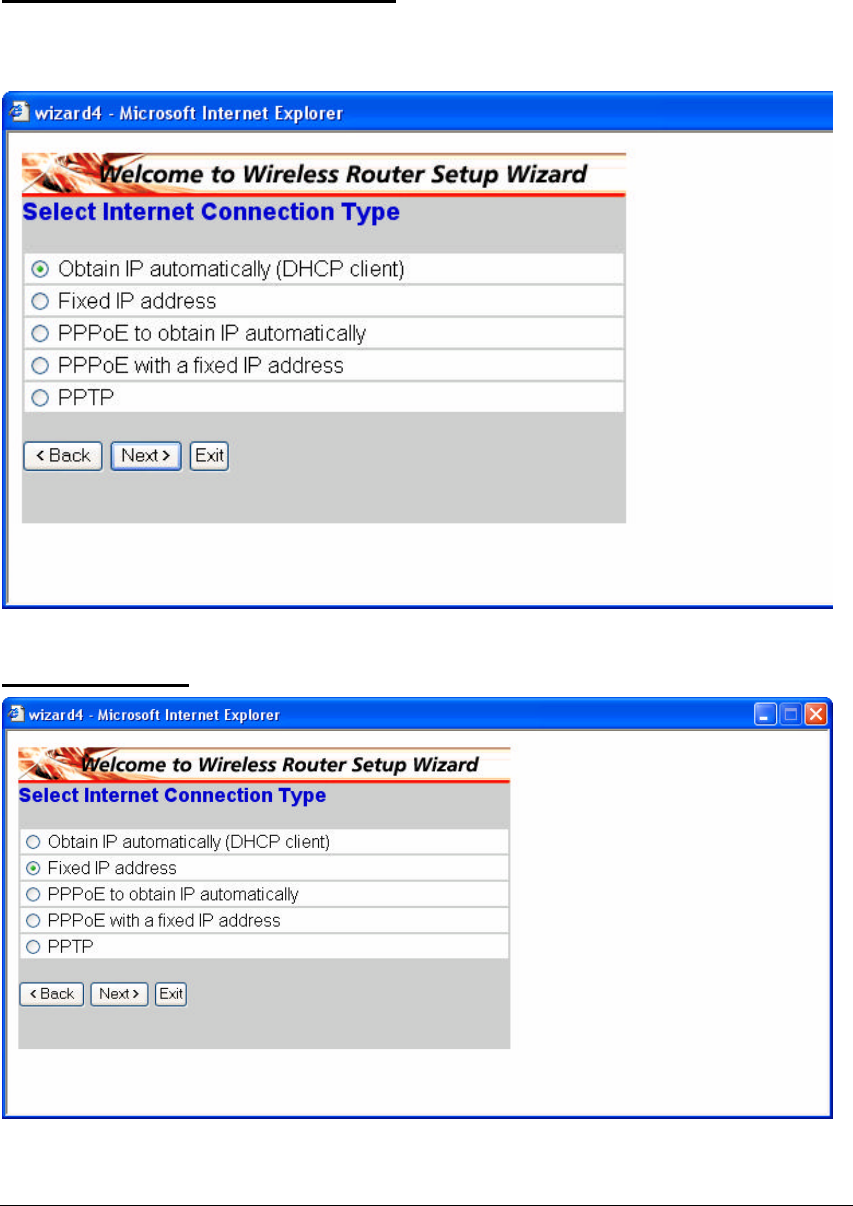
7
Step 4: Set Internet connection
Select how the router will set up the Internet connection: Obtained IP automatically;
Fixed IP address; PPPoE to obtain IP automatically; PPPoE with a fixed IP address;
PPTP.
Obtain IP automatically (DHCP client):
If you have enabled DHCP server, choose "Obtain IP automatically (DHCP client)" to
have the router assign IP addresses automatically.
Fixed IP Address:
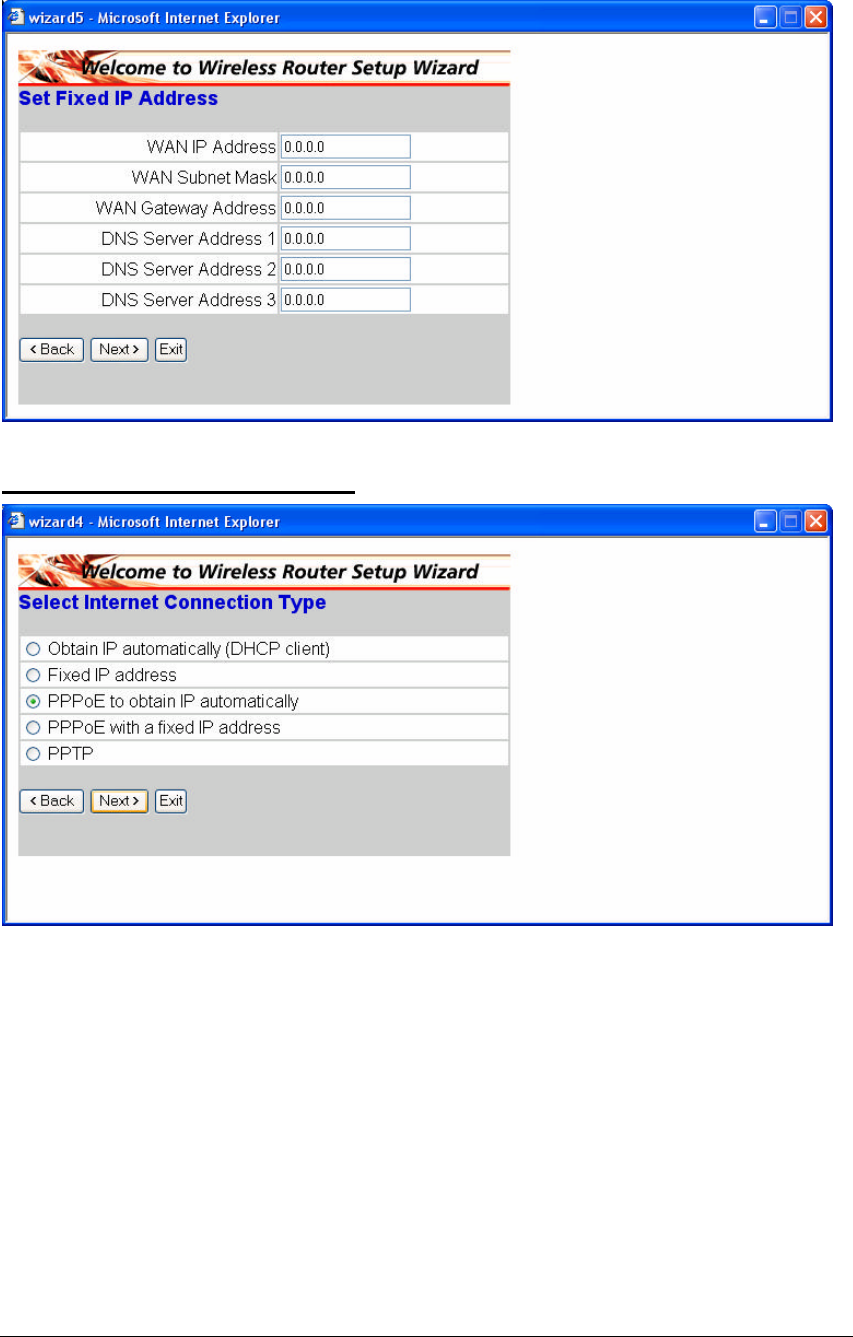
8
If Fixed IP address is assigned, the below screen will pop up. Please set the WAN
address and DNS server.
PPPoE to obtain IP automatically:
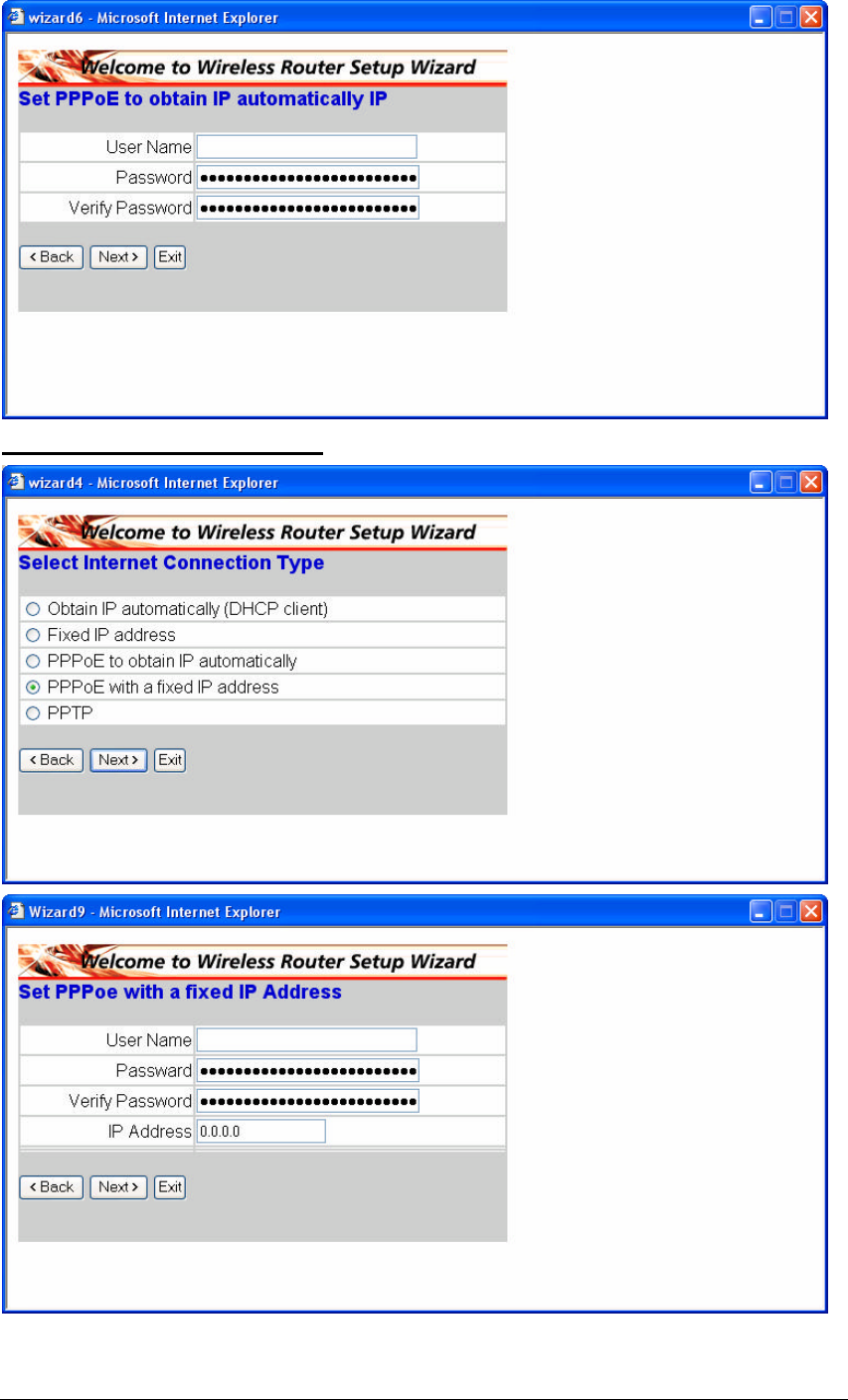
9
PPPoE with a fixed IP address:
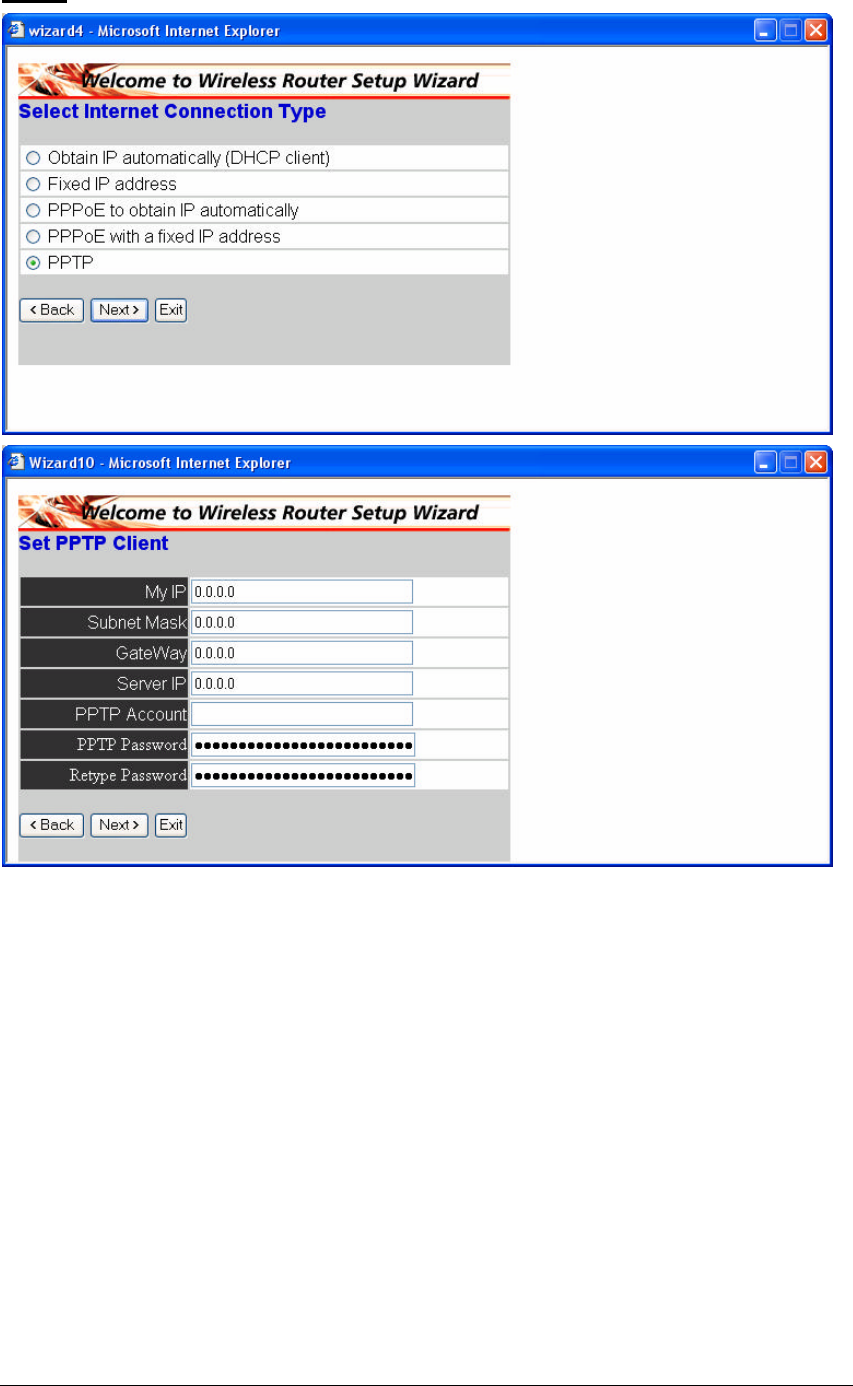
10
PPTP:
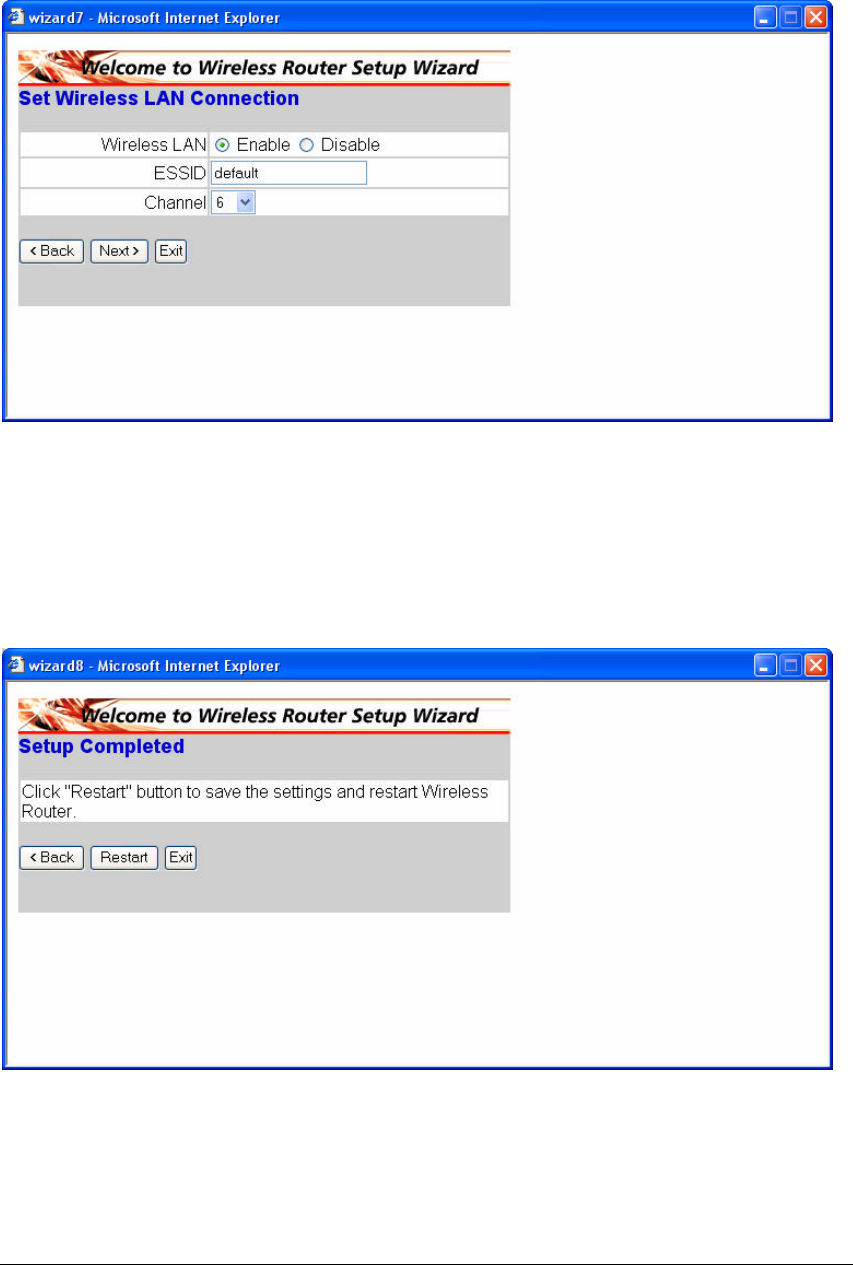
11
Step 5: Set Wireless LAN connection
Click “enable” to enable wireless LAN. If you enable the wireless LAN, type the SSID in
the text box and select a communications channel. The SSID and channel must be the
same as wireless devices attempting communication to the router.
Step 6: Restart
The Setup wizard is now completed. The new settings will be effective after the
Wireless router restarted. Please click “Restart” to reboot the router. If you do not
want to make any changes, please click “exit” to quit without any changes. You also
can go back to modify the setting by clicking “Back”.
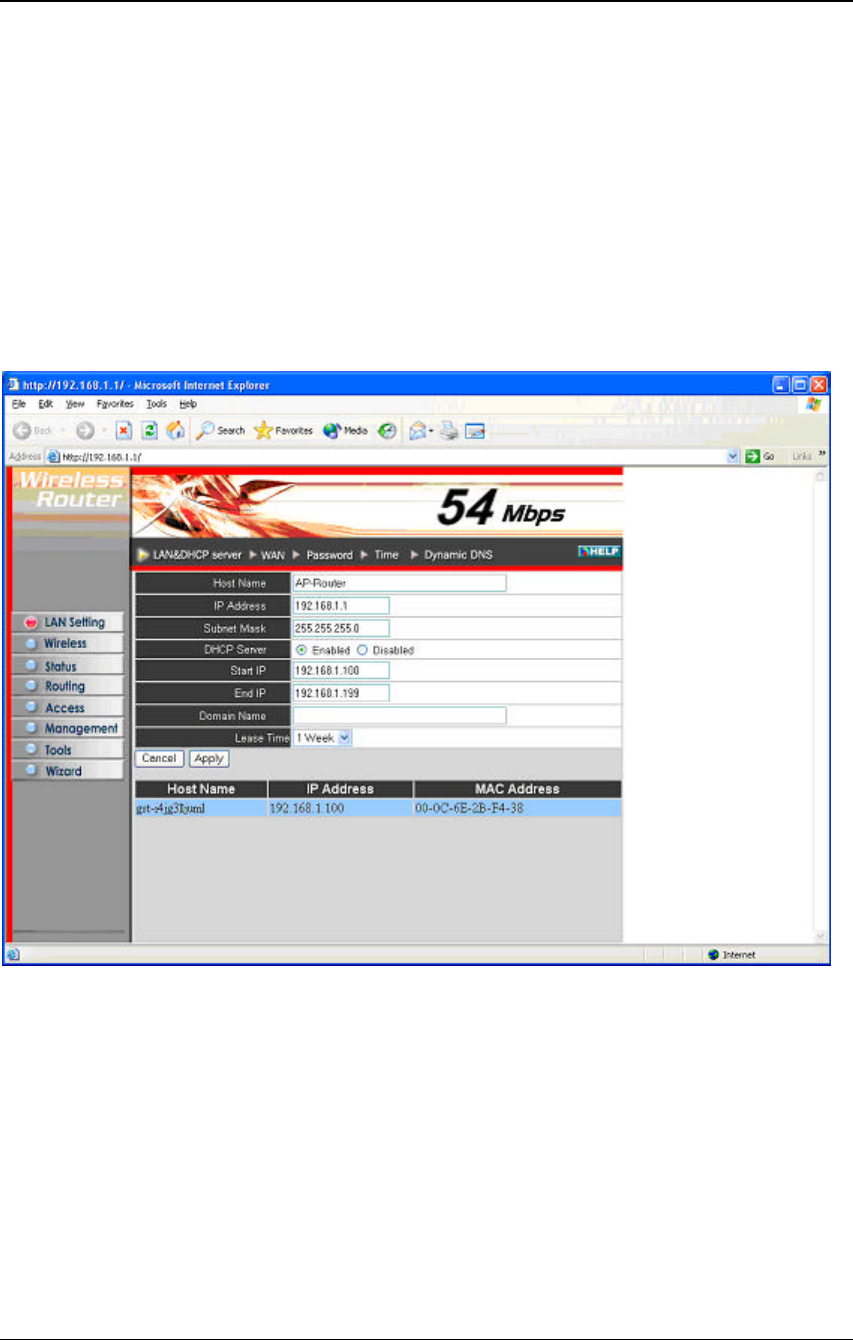
12
3. Configuration
3.1 LAN Setting
The screen enables you to configure the LAN & DHCP Server, set WAN parameters,
create Administrator and User passwords, and set the local time, time zone, and
dynamic DNS.
3.1.1 LAN & DHCP Server
This page enables you to set LAN and DHCP properties, such as the host name, IP
address, subnet mask, and domain name. LAN and DHCP profiles are listed in the
DHCP table at the bottom of the screen.
Host Name: Type the host name in the text box. The host name is required by some
ISPs. The default host name is "AP-Router."
IP Address: This is the IP address of the router. The default IP address is 192.168.1.1.
Subnet Mask: Type the subnet mask for the router in the text box. The default subnet
mask is 255.255.255.0.
DHCP Server: Enables the DHCP server to allow the router to automatically assign IP
addresses to devices connecting to the LAN. DHCP is enabled by default.
All DHCP client computers are listed in the table at the bottom of the screen, providing
the host name, IP address, and MAC address of the client.
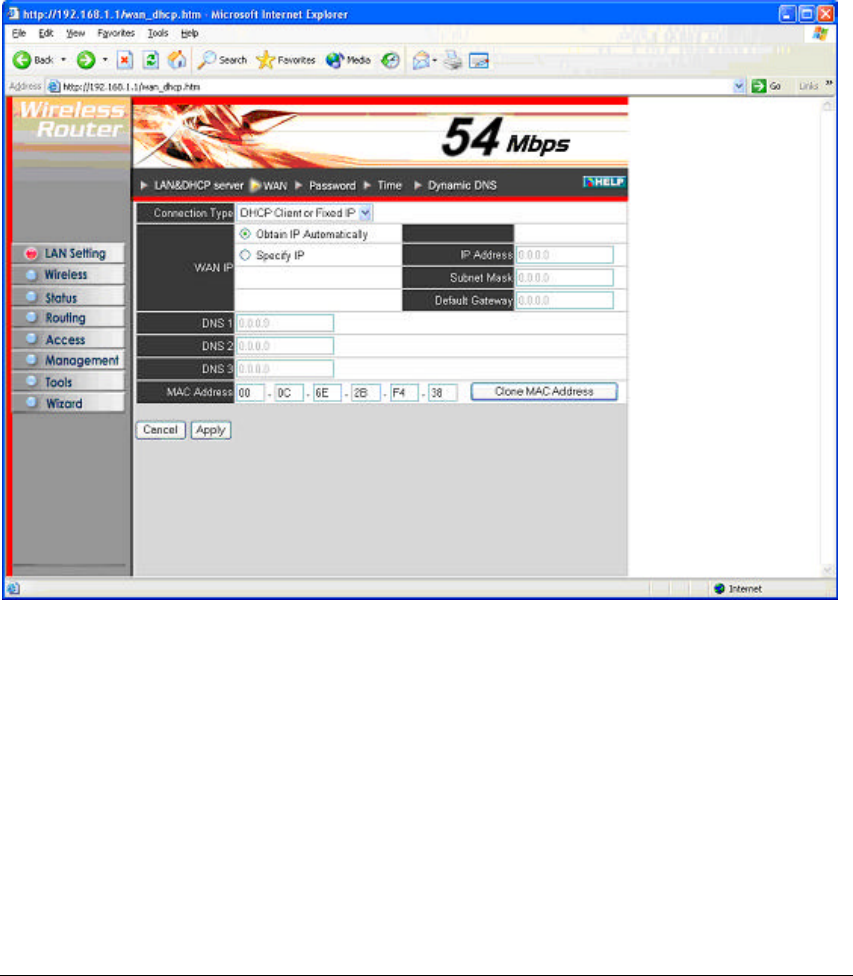
13
Start IP: Type an IP address to serve as the start of the IP range that DHCP will use to
assign IP addresses to all LAN devices connected to the router.
End IP: Type an IP address to serve as the end of the IP range that DHCP will use to
assign IP addresses to all LAN devices connected to the router.
Domain Name: Type the local domain name of the network in the text box. This item is
optional.
3.1.2 WAN
This screen enables you to set up the router WAN connection, specify the IP address
for the WAN, add DNS numbers, and enter the MAC address.
Connection Type: Select the connection type, either DHCP client, Fixed IP or PPPoE
from the drop-down list.
WAN IP: Select whether you want to specify an IP address manually, or want DHCP to
obtain an IP address automatically. When Specify IP is selected, type the IP address,
subnet mask, and default gateway in the text boxes. Your ISP will provide you with this
information.
DNS 1/2/3: Type up to three DNS numbers in the text boxes. Your ISP will provide you
with this information.
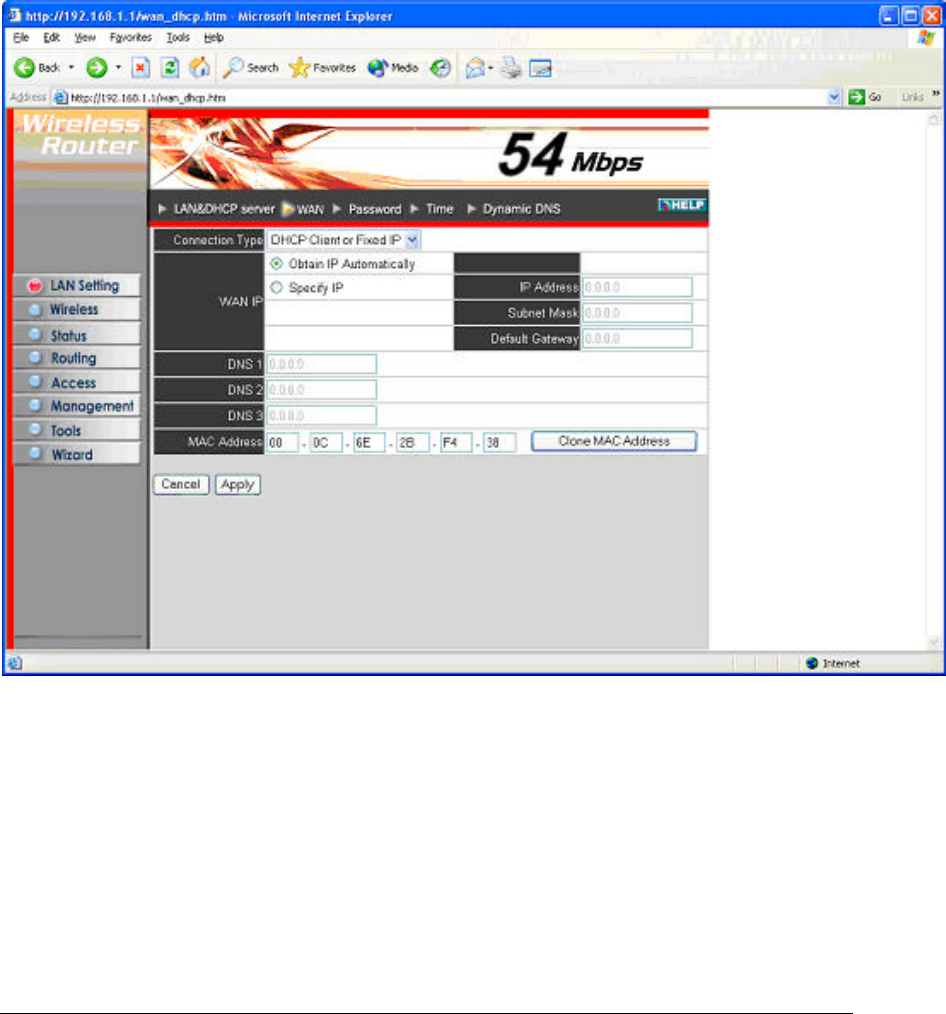
14
MAC Address: If required by your ISP, type the MAC address of the router WAN
interface in this field.
DNS 1/2/3: Type up to three DNS numbers in the text boxes. Your ISP will provide you
with this information.
3.1.3 Password
This screen enables you to set administrative and user passwords. These passwords
are used to gain access to the router interface.
Administrator: Type the password the Administrator will use to log in to the system.
The password must be typed again for confirmation.
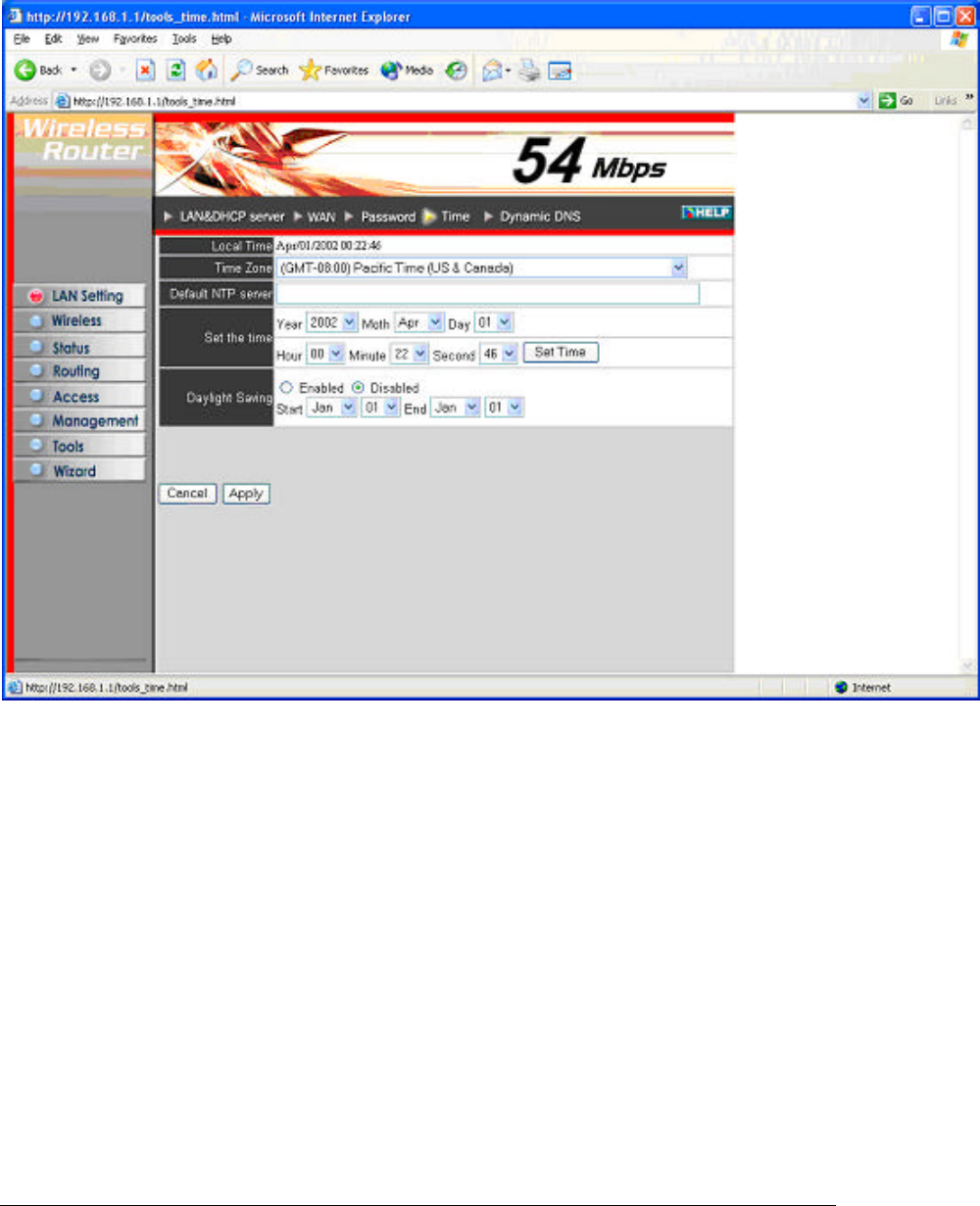
15
3.1.4 Time
This screen enables you to set the time and date for the router's real-time clock, select
your time zone, and enable or disable daylight saving.
Local Time: Displays the local time and date.
Time Zone: Select your time zone from the drop-down list.
Daylight Saving: Enables you to enable or disable daylight saving time. When enabled,
select the start and end date for daylight saving time.
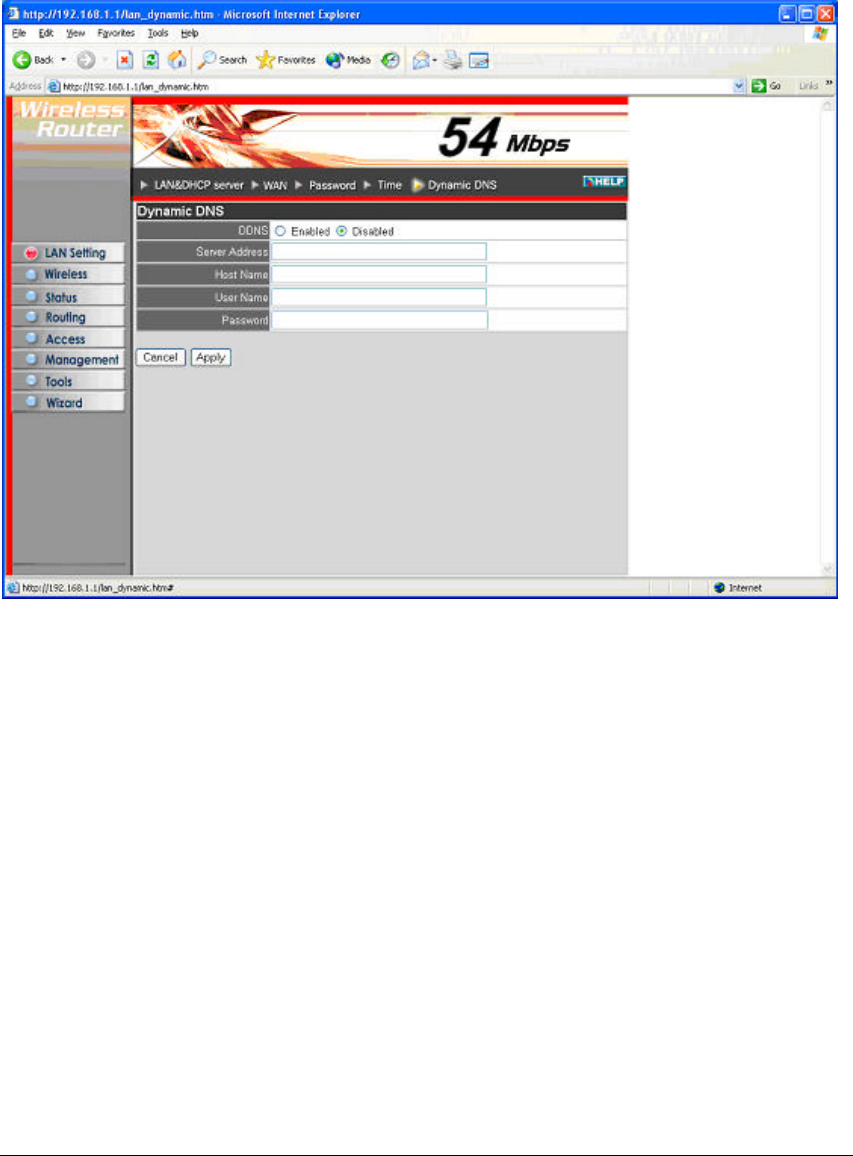
16
3.1.5 Dynamic DNS
This allows the DDNS server what your current IP address is when you are on-line.
You firstly need to register your preferred DNS on the DDNS providers. Then, please
fill the related information in the below fields: DDNS server address, Host Name, User
Name and Password.
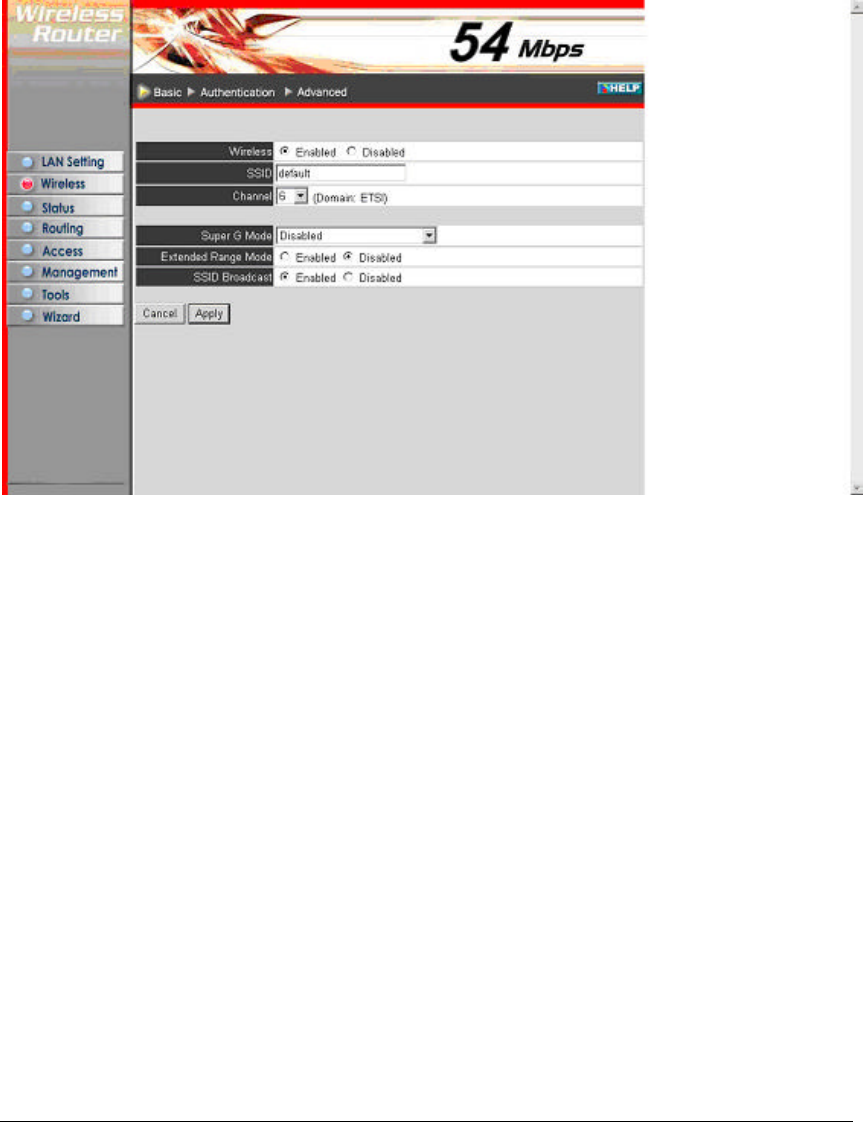
17
3.2 Wireless
This section enables you to set wireless communications parameters for the router's
wireless LAN feature.
3.2.1 Basic
This page allow you to enable and disable the wireless LAN function, create a SSID,
and select the channel for wireless communications.
Enable/Disable: Enables and disables wireless LAN via the router.
SSID: Type an SSID in the text box. The SSID of any wireless device must match the
SSID typed here in order for the wireless device to access the LAN and WAN via the
router.
Channel: Select a transmission channel for wireless communications. The channel of
any wireless device must match the channel selected here in order for the wireless
device to access the LAN and WAN via the router.
Super G mode: Super G mode is disabled by selecting “Disable” from the drop list. If
you like to use Super G to enhance the speed, there are three options on Super G
mode: Super G without turbo; Super G with Dynamic turbo and Super G with Static
turbo. Turbo mode indicates the combination of two channels to enhance the
throughput. Super G without turbo indicates that it is on Super G mode without the
channel’s combination. Dynamic turbo is able to automatically detect if any ‘SuperG
based’ product is available. If no, the connection is via ‘normal’ G.. Static turbo
means it will not go back to ‘normal’ G once it starts.
Extended Range Mode: Enable and disable wireless LAN via router.
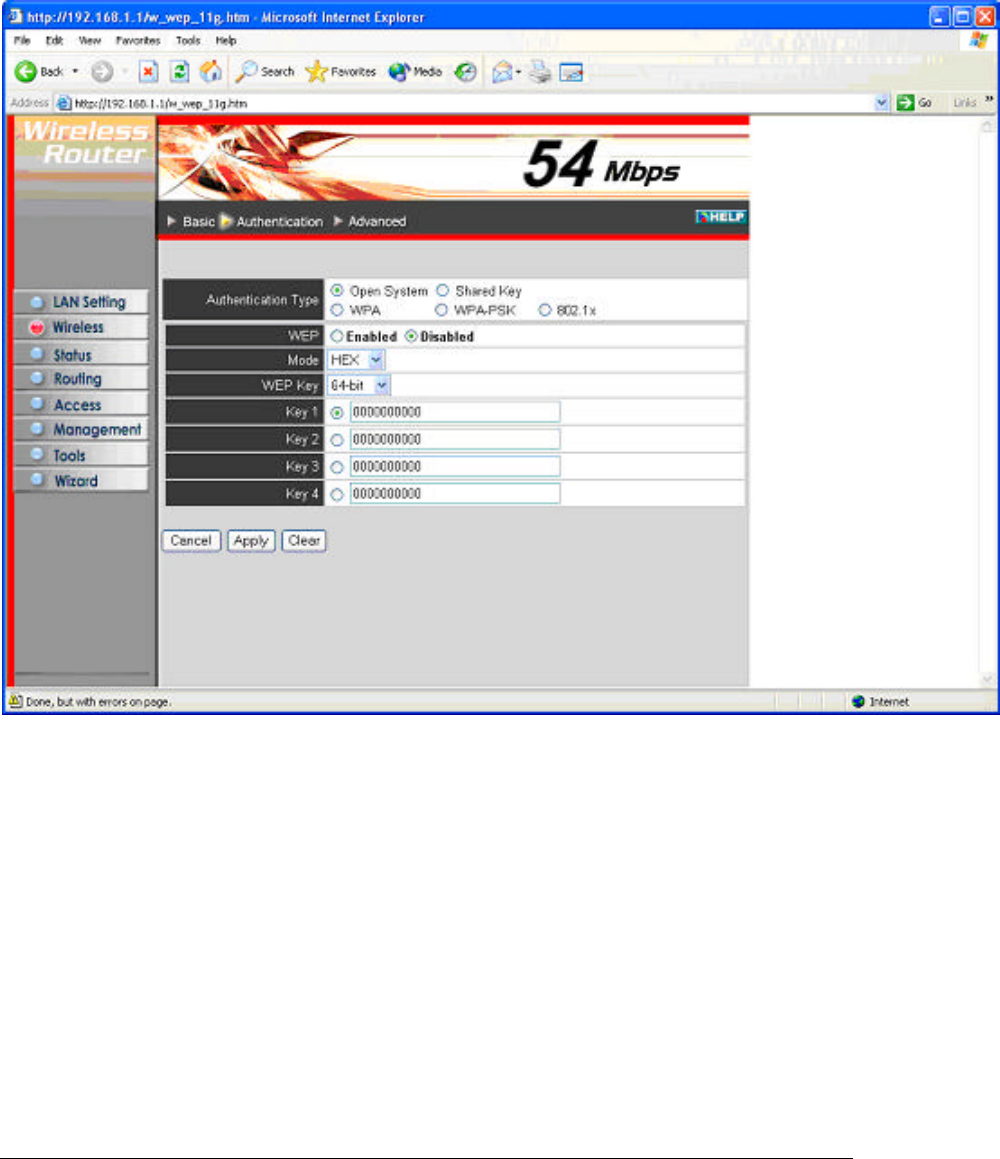
18
3.2.2 Authentication
This screen enables you to set authentication type for secure wireless communications.
Open System allows public access to the router via wireless communications. Shared
Key requires the user to set a WEP key to exchange data with other wireless clients that
have the same WEP key. This router also support WPA, WPA-PSK and 802.1X.
Authentication Type: The authentication type default is set to open system. There
are five options: Open System; Shared Key; WPA; WPA-PKS and 802.1X.
WEP: Enable or Disabled.
Mode: Select the level of encryption you want from the drop-down list. The router
supports, 64- and 128-bit encryption.
WEP Key: Select WEP Key - 64 or 128 bits from the drop-down list.
Key 1 ~ Key 4: Enables you to create an encryption scheme for Wireless LAN
transmissions. Manually enter a set of values for each key. Select which key you want
to use by clicking the radio button next to the key. Click Clear to erase key values.
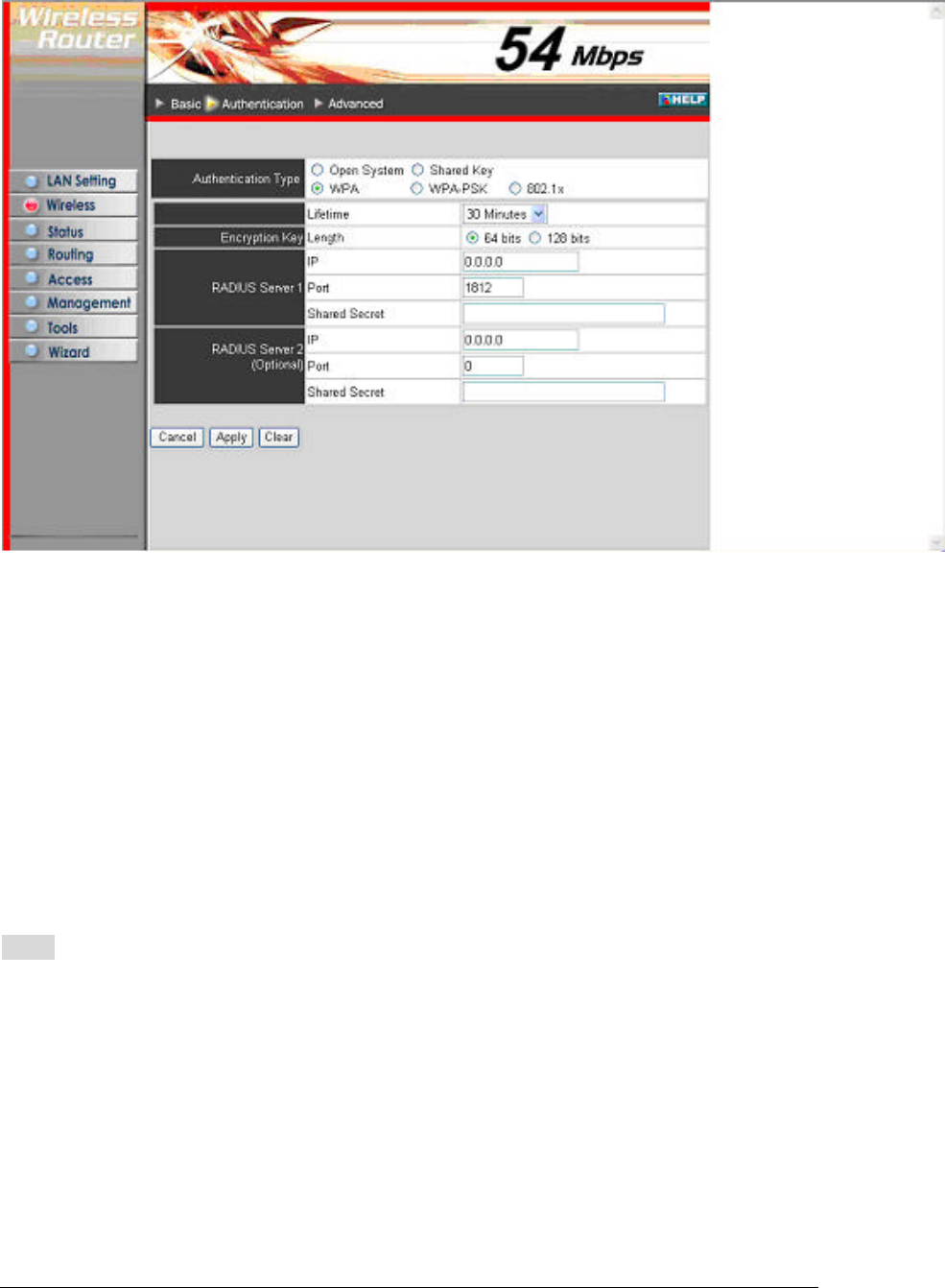
19
If WPA or 802.1X is selected, the below screen is shown. Please set the length of the
encryption key and the parameters for the RADIUS server.
Lifetime: Select the Lifetime of the Encryption Key from 5 Minutes to 1 Day. As soon
as the lifetime of the Encryption Key is over, the Encryption Key will be renewed by the
Radius server.
Encryption Key: Select the Encryption Key Length Size ranging from 64 to 128 Bits
that you would like to use.
RADIUS Server:
1. Enter the IP address of and the Port used by the Primary Radius Server
Enter the Shared Secret, which is used by the Radius Server.
2. Enter the IP address of, Port and Shared Secret used by the Secondary Radius
Server.
Note: As soon as 802.1X security is enabled, all the wireless client stations that are
connected to the Router currently will be disconnected. The wireless clients must be
configured manually to authenticate themselves with the Radius server to be
reconnected.
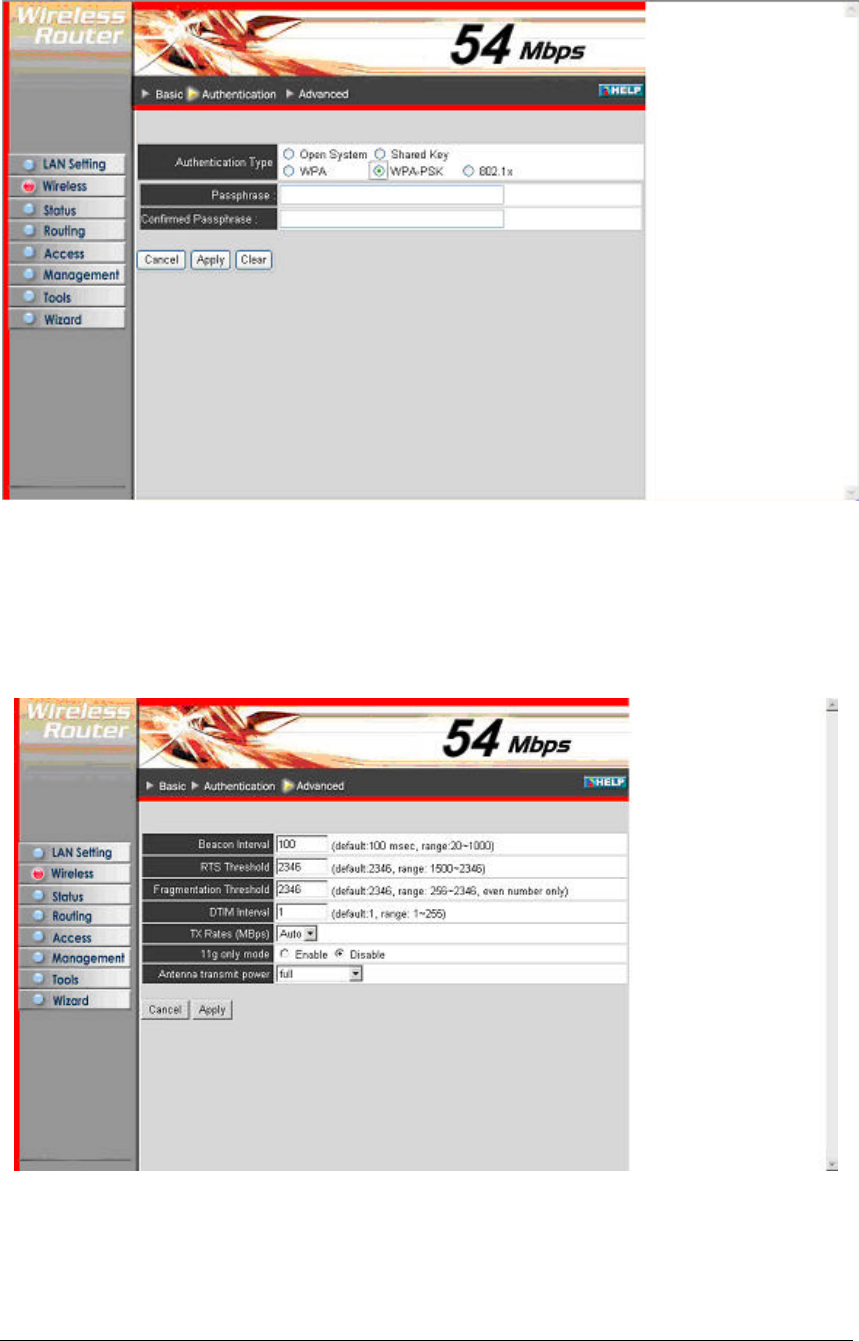
20
If WPA-PSK is selected, please set the PSK key in the passphrase field. The length
should be 8 characters at least.
3.2.3 Advanced
This screen enables you to configure advanced wireless functions.

21
Beacon Interval: Type the beacon interval in the text box. You can specify a value from
1 to 1000. The default beacon interval is 100.
RTS Threshold: Type the RTS (Request-To-Send) threshold in the text box. This value
stabilizes data flow. If data flow is irregular, choose values between 256 and 2432 until
data flow is normalized.
Fragmentation Threshold: Type the fragmentation threshold in the text box. If packet
transfer error rates are high, choose values between 256 and 2432 until packet transfer
rates are minimized. (NOTE: set this fragmentation threshold value may diminish
system performance.)
DTIM Interval: Type a DTIM (Delivery Traffic Indication Message) interval in the text
box. You can specify a value between 1 and 65535. The default value is 3.
TX Rates (MBps): Select one of the wireless communications transfer rates, measured
in megabytes per second, based upon the speed of wireless adapters connected to the
WLAN.
11g only mode: enable or disable.
Antenna Transmit Power: Adjust the power of the antenna transmission by selecting
from the dropping list.
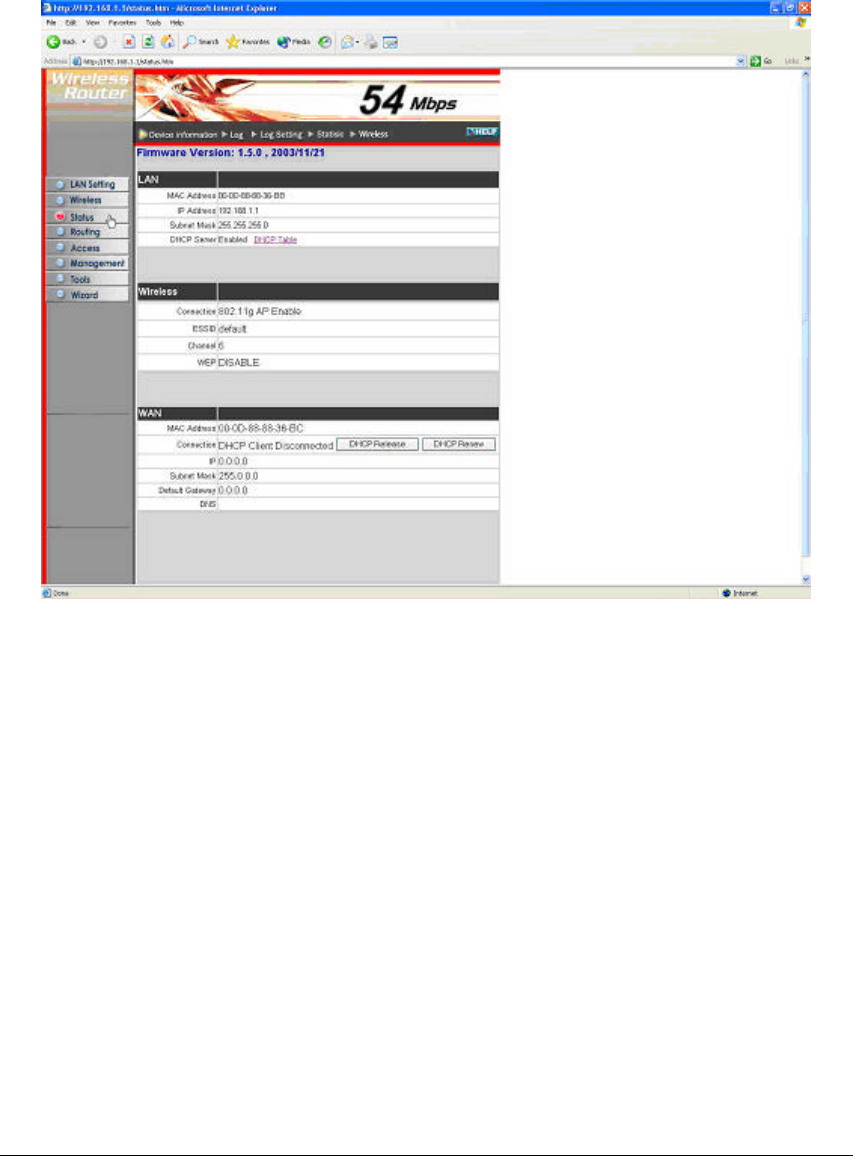
22
3.3 Status
This selection enables you to view the status of the router LAN, WAN connections, and
view logs and statistics pertaining to connections and packet transfers.
3.3.1 Device Information
This screen enables you to view the router LAN, Wireless and WAN configuration.
Firmware Version: Displays the latest build of the router firmware interface. After
updating the firmware in Tools - Firmware, check this to ensure that your firmware was
successfully updated.
LAN: This field displays the router's LAN interface MAC address, IP address, subnet
mask, and DHCP server status. Click DHCP Table to view a list of client stations
currently connected to the router LAN interface.
Wireless: Displays the router's wireless connection information, including the router's
wireless interface MAC address, the connection status, the SSID status, which channel
is being used, and whether WEP is enabled or not.
WAN: This field displays the router's WAN interface MAC address, DHCP client status,
IP address, subnet mask, default gateway, and DNS.
Click DHCP Release to release all IP addresses assigned to client stations connected
to the WAN via the router. Click DHCP Renew to reassign IP addresses to client
stations connected to the WAN.